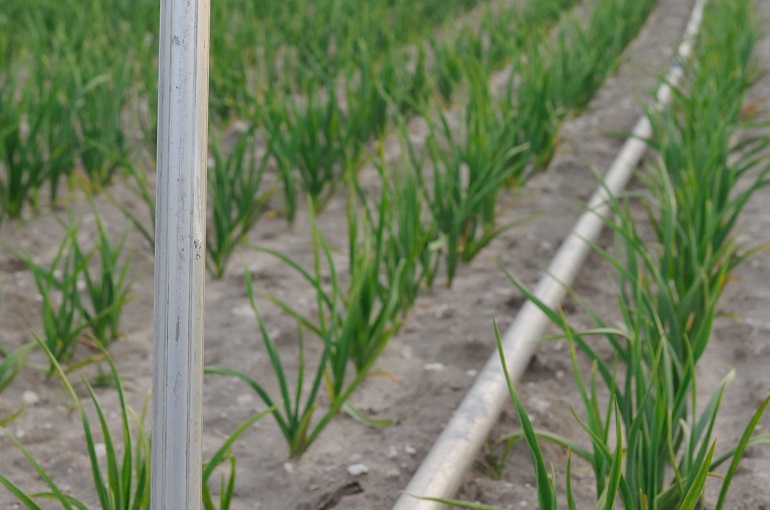Garlic Fertilization Requirements

This post is also available in:
This post is also available in:
![]() Deutsch (German)
Deutsch (German) ![]() हिन्दी (Hindi)
हिन्दी (Hindi) ![]() Ελληνικά (Greek)
Ελληνικά (Greek)
Nutrient needs of Garlic
First of all, as a garlic grower has to take into consideration the soil condition of your field through semiannual or annual soil testing before applying any fertilization method. It is advised to perform one soil and irrigation water analysis before planting the cloves of garlic and one tissue analysis soon after sprouting (especially in fields where they are cultivated intensively). The results of this analysis will reveal information concerning the soil characteristics and the amount and availability of nutrients. Depending on these data and considering the crop density, the variety, and the environmental conditions (e.g., availability of water, temperatures) during the growing season, the farmer can form a suitable fertilization program. No two fields are the same, nor can anyone advise you on fertilization methods without taking into account your soil’s test data, tissue analysis, and crop history of your field. However, we will list the most common garlic fertilization schemes many farmers use.
Garlic is a heavy feeder, requiring relatively high amounts of nutrients to grow and produce measurable yields. Commercial growers use liquid and granular fertilizers for garlic cultivation, while manure and plant-based products are also suitable. Nowadays, farmers may perform up to 4 fertilizers applications during the 3 to 8 months from planting to harvesting garlic. The decision regarding the time of the application (especially the first 2) and the type of fertilizer should be based on the pH of the field’s soil and the moment of planting and harvesting. For example, in soils with a pH lower than 5.5-5.8, the farmers are advised to use dolomitic or calcitic lime to raise the pH. On the contrary, to lower the pH, sulfur can be used. In general, 60-300 kg (54-270 lb/acre) of Nitrogen (N), 50-200 kg (45-180 lb/acre) of Phosphorus (P2O5, and 80-300 kg (70-270 lb/acre) of Potassium (K₂O) per hectare may be applied in a garlic field during the entire growing period. However, numerous examples prove that even the lowest amounts suggested above are more than enough for profitable garlic cultivation.
Usually, the first and basic application of fertilizers takes place before planting. Many farmers start by applying well-rotted manure (or compost) in plant rows about 1 month before planting to enrich the soil with organic matter.
More specifically, Nitrogen should be split into multiple doses to reduce the risk of nutrient runoff and supply the plants when they most need it. In general, urea is widely used.
- If the crop is planted in the fall (and expected to be harvested in late spring), it is best to apply only a small amount of the Nitrogen before planting (56-84 kg/ha or 50-75 lb/acre), in a slow-released form. In organic-rich soil, where manure or compost has been applied in the fall, there might not be any need for extra nitrogen fertilization in spring.
- On the contrary, if planting takes place in spring (and the harvest during summer), then up to 50% of the Nitrogen (urea) is applied as basic fertilization just before or one week after planting.
When sprouting starts or plants are 15-25 cm (6-10 in) tall in early spring, the first side dressings should take place. In this case, urea (70-120 kg per hectare or 63-107 lb/acre) is usually used. The rest of the Nitrogen can be split into 3-4 applications, one every 2 weeks until the bulbing stage of garlic. Suppose fertigation (through the drip irrigation system) is applied. In that case, the farmer can incorporate 30 kg per hectare (27 lb/acre) of N into the soil as basal fertilization and continue with 7-8 doses spread in a period of approximately 2 months by using calcium or ammonium nitrate sources.
The complete amount of phosphorus and potassium, if needed, should be applied before planting. In some cases, potassium may be split and applied into 2 doses. In case the soil already has quite a high amount of phosphorus, you are advised to use fertilizers with lower or no phosphorus for the basic pre-planting application, like 32-2-10 or 24-0-15, etc. If the farmer has applied 50% of the potassium needed before planting, the rest should be incorporated into the soil after the bubbling stage of garlic (around 85-120 kg per hectare). The plants’ needs for nutrients like Mg and Ca (especially in acidic soils) can be covered by applying up to 60 and 30 kg per hectare (54 and 27 lb per acre), respectively. Sulfur and micronutrients (Zn, B, Cu) should also be added before planting or with foliar sprays (depending on the element). More specifically, farmers usually perform foliar applications with zinc, using zinc sulfate (4 g/L).
However, these are just common patterns that should not be followed without doing your own research. Every field is different and has different needs. Checking the soil condition and pH is vital before applying any fertilization method. You can consult your local licensed agronomist.
References
- http://www.omafra.gov.on.ca/english/crops/facts/09-011w.htm
- https://extension.psu.edu/garlic-production#section-2
- https://coststudyfiles.ucdavis.edu
- https://extension.umn.edu/vegetables/growing-garlic#soil-testing-and-fertilizer-867210
- https://extension.uga.edu/publications/detail.html?number=C854#Garlic%20Cultivars
- https://www.nda.agric.za/docs/brochures/prodguidegarlic.pdf
- https://www.agric.wa.gov.au/garlic/growing-garlic-western-australia?nopaging=1
- https://dogr.icar.gov.in/index.php?option=com_content&view=article&id=131&Itemid=198&lang=en
- https://horticulture.oregonstate.edu/oregon-vegetables/garlic-1
- https://www.dpi.nsw.gov.au/__data/assets/pdf_file/0005/97709/growing-garlic-in-NSW.pdf
- https://cvp.cce.cornell.edu/submission.php?id=763
- https://www.gov.mb.ca/agriculture/crops/crop-management/pubs/bmz00s10p.pdf
Further reading:
Garlic Plant information and Variety selection
General information and nutritional value of Garlic
Growing garlic in your backyard
Growing Garlic Commercially – Complete Growing Guide for Garlic from Start to Finish
Soil Requirements, Soil Preparation, and Planting of Garlic
Garlic Water Requirements and Irrigation Systems
Garlic Fertilization Requirements








































































